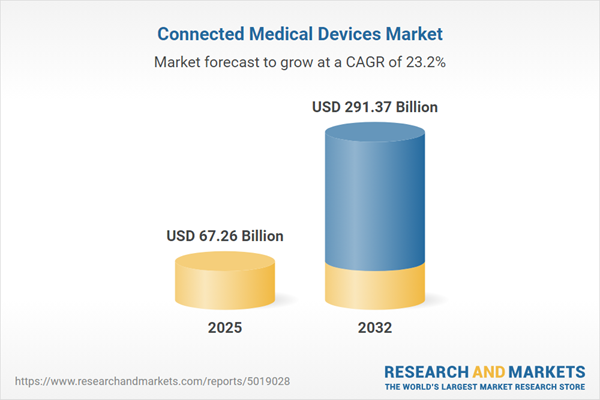Speak directly to the analyst to clarify any post sales queries you may have.
The connected medical devices market is redefining healthcare delivery, enabling digital integration that streamlines clinical operations and enhances decision-making for forward-thinking executive teams. Organizations embracing these solutions can realize new efficiencies and strengthen their position as healthcare continues to digitize.
Market Snapshot: Connected Medical Devices Market
The connected medical devices market is undergoing robust growth as healthcare systems worldwide accelerate digital adoption. Market expansion is driven by the necessity for real-time connectivity across medical equipment, advancing seamless clinical collaboration and improving patient outcomes. Senior leaders are navigating an increasingly complex technological landscape, where regulatory and operational requirements are rapidly evolving. The integration of connected medical devices now determines a health organization's competitive edge, empowering strategic decision makers to focus on patient engagement, achieve regulatory objectives, and streamline care delivery processes. Investment in interoperable solutions is shaping how care teams coordinate in both acute and remote scenarios.
Scope & Segmentation of the Connected Medical Devices Market
The report delivers comprehensive insights supporting executive decisions for new investments or expansion within the connected medical devices sector. Its market segmentation enables precise planning, resource deployment, and business development across critical categories:
- Product Types: Diagnostic devices, monitoring equipment, therapeutic tools, and wearable devices support patient care continuity and improve interoperability of health data exchange.
- Applications: Drug delivery systems, diagnostic imaging, procedural guidance, remote monitoring, rehabilitation support, telehealth, and neurotherapy improve clinical workflows and address varied patient health needs.
- End Users: Hospitals, ambulatory surgical clinics, diagnostic centers, specialty care providers, and home health organizations use connected devices to support distinct care models and patient journeys.
- Connectivity Technologies: Secure data transfer via Bluetooth, BLE, Wi-Fi, Zigbee, NFC, and cellular networks underpins scalable and efficient healthcare environments, supporting both centralized and distributed care settings.
- Distribution Channels: Digital procurement platforms and global supply networks ensure consistent, reliable access to medical devices for healthcare providers on a regional and international scale.
- Geographic Regions: North America, South America, Europe, Middle East, Africa, and Asia-Pacific each offer diverse market opportunities and regulatory considerations. Asia-Pacific, in particular, is experiencing rapid growth due to local technology innovation.
- Key Companies: Prominent industry contributors include Koninklijke Philips N.V., General Electric Company, Medtronic plc, Johnson & Johnson, Abbott Laboratories, Boston Scientific Corporation, Baxter International Inc., ResMed Inc., Dexcom, Inc., and Siemens Healthineers AG. These organizations shape technology standards and drive market adoption.
Key Takeaways for Senior Decision Makers
- Advanced analytics and reliable wireless interoperability are foundational for optimizing both centralized and remote patient care, equipping care teams for agile clinical decisions.
- Strategic collaboration with regulatory agencies streamlines device compliance, ensuring seamless technology integration as requirements and standards evolve.
- Remote monitoring and telehealth solutions provide healthcare continuity during demand fluctuations, enabling organizations to adapt quickly to operational pressures.
- Adaptable risk management and regulatory oversight are essential for maintaining organizational agility as policies shift within global markets.
- Focusing on interoperability and modular device solutions allows health providers to expand clinical reach and better serve varied patient demographics, optimizing care delivery across multiple settings.
- Pursuing localization strategies tailored to regional regulatory and infrastructure differences supports timely market entry and ongoing compliance across geographies.
Tariff Impact Across Connected Medical Device Supply Chains
Evolving U.S. tariff regulations are having a direct impact on procurement strategies across the connected medical device supply chain. To address potential cost fluctuations and reduce supplier risks, stakeholders are diversifying sourcing by considering nearshoring and engaging a wider vendor network. This approach ensures steady device availability as international trade and regulatory frameworks continue to develop.
Methodology & Data Sources
This report combines direct consultation with healthcare executives, assessment of the latest regulatory directives, and rigorous market data validation. Engagement with peers ensures the findings and strategic recommendations align with top executive priorities and reflect the present state of digital health adoption.
Why This Report Matters
- Supports executive teams in making data-backed investment decisions, establishing strategic partnerships, and maintaining operational alignment within digital healthcare.
- Offers actionable insights into connected medical devices and evolving regulatory demands, enabling the creation of flexible and scalable business models.
- Prepares organizations to recognize and navigate regional risks and opportunities, facilitating global expansion and local market adaptation strategies.
Conclusion
Success in the connected medical devices market depends on continuous innovation, strong partnerships, and regulatory focus. Executive leadership committed to digital transformation will be prepared for challenges and positioned for new opportunities.
Additional Product Information:
- Purchase of this report includes 1 year online access with quarterly updates.
- This report can be updated on request. Please contact our Customer Experience team using the Ask a Question widget on our website.
Table of Contents
3. Executive Summary
4. Market Overview
7. Cumulative Impact of Artificial Intelligence 2025
Companies Mentioned
The companies profiled in this Connected Medical Devices market report include:- Koninklijke Philips N.V.
- General Electric Company
- Medtronic plc
- Siemens Healthineers AG
- Johnson & Johnson
- Abbott Laboratories
- Boston Scientific Corporation
- Baxter International Inc.
- ResMed Inc.
- Dexcom, Inc.
Table Information
| Report Attribute | Details |
|---|---|
| No. of Pages | 189 |
| Published | October 2025 |
| Forecast Period | 2025 - 2032 |
| Estimated Market Value ( USD | $ 67.26 Billion |
| Forecasted Market Value ( USD | $ 291.37 Billion |
| Compound Annual Growth Rate | 23.2% |
| Regions Covered | Global |
| No. of Companies Mentioned | 11 |









